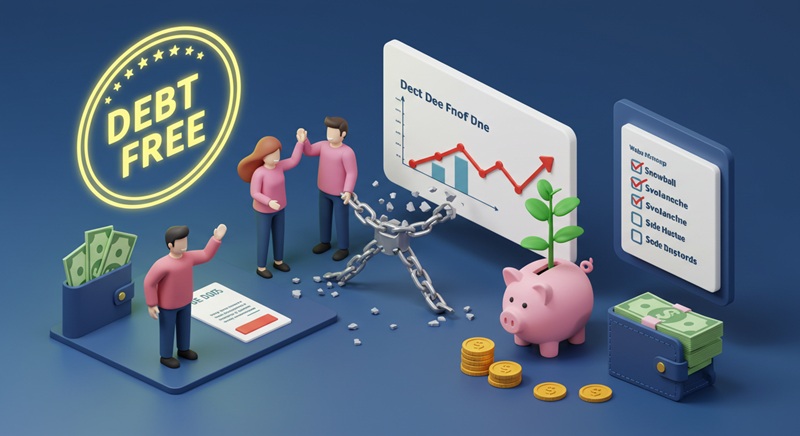The Psychology of Spending: Why We Spend & How to Stop

Ever bought something on impulse and regretted it later? You’re not alone. Most of us have been there—walking into a store for one thing and walking out with five. It’s not just lack of self-control; our brains are wired in surprising ways that influence how, when, and why we spend money.
Understanding the psychology of spending can be a game-changer for your financial health. This blog breaks down why we spend, common spending personalities, and how to regain control with simple, practical tips. Also check our article on rewiring your brain for success for more tips on personal development.
Why Do We Spend? The Psychology Behind Our Habits
Emotional Spending
We often think money decisions are logical—but emotions run the show more than we realize. Ever noticed how you tend to shop when you’re stressed, bored, or even celebrating something? That’s emotional spending in action.
Stress and sadness can push us to seek comfort. Happiness can lead us to “treat ourselves.” It’s all linked to dopamine, the “feel-good” brain chemical. When we buy something new, dopamine gives us a short-lived high—kind of like a reward. That’s why shopping can feel addictive.
Example: Think about the last time you bought something after a tough day. Did it really solve the problem—or just give you a momentary boost?
Social Influences
Let’s be honest—social media makes it way too easy to fall into spending traps. Scrolling through Instagram or TikTok, it’s hard not to feel like you’re missing out (hello, FOMO). Whether it’s the latest phone, fashion trend, or travel destination, we’re bombarded with messages that say, “You need this to be happy.”
And then there are the ads. Modern advertising doesn’t just show products—it tells stories, sells lifestyles, and plays on emotions. It’s no accident that you suddenly want those shoes you saw in an ad five minutes ago.
Cognitive Biases
Now, let’s talk about some sneaky mental tricks our brains play on us.
- Retail Therapy Myth: Buying things might feel like self-care, but the joy fades fast. It’s often followed by guilt or buyer’s remorse.
- The Discount Illusion: Just because something is “on sale” doesn’t mean it’s a smart purchase. In fact, people often spend more during sales, thinking they’re saving money—even when they buy things they don’t need.
Understanding these triggers can help you pause and rethink before swiping your card.
Common Spending Personalities – Which One Are You?
Not all spenders are the same. Knowing your “money personality” can help you spot habits that need adjusting. So, which type are you?
The Impulse Buyer
You see it. You want it. You buy it.
Impulse buyers make snap decisions. It might be snacks at checkout or a gadget they didn’t plan for. Later, they often feel regret or wonder where all their money went.
Tip: If this is you, try the 24-hour rule. Wait a day before buying non-essentials.
The Bargain Hunter
You love a good deal—sometimes a little too much. Sales and discounts are your playground, but they can also lead to buying stuff you never actually use.
Scenario: You buy three shirts at 50% off. Great deal, right? But if you only wear one, did you really save?
The Emotional Spender
Your cart is full when your emotions are high. You shop to celebrate, mourn, or cope. It might feel helpful in the moment, but it can damage your long-term finances.
Advice: Replace shopping with healthy coping mechanisms like journaling, walking, or calling a friend.
The Avoidant Spender
Budgets? Bank balances? You’d rather not look. This type avoids financial stress by pretending it doesn’t exist—but that only makes things worse.
Solution: Start small. Check your balance once a week and track your expenses just for a few days. Knowledge is power.
Identifying your spending personality isn’t about shame—it’s about self-awareness and growth.
How to Break Bad Spending Habits
Breaking habits isn’t always easy, but it’s absolutely possible with small, consistent changes.
Track Your Spending
This is step one. You can’t fix what you don’t understand. Use a notebook, spreadsheet, or budgeting app to see exactly where your money goes each week.
You might be surprised how those daily coffees or impulse buys add up.
Set Clear Financial Goals
Having a reason to save helps curb spending. Do you want to build an emergency fund? Save for a vacation? Pay off debt?
Write down your goals and break them into small, achievable steps.
Tip: Try labeling your savings accounts. For example—“Future Trip Fund” or “Emergency Backup.” This makes it feel more real and motivating. Our article on how to stick to a budget explore this point further.
Delay Purchases
Impulse buying loses its grip when you wait. The 24-hour rule gives you time to think—do you really need it, or was it just a momentary desire?
Bonus: Add items to a “wishlist” instead of buying them right away. Review the list weekly to see if you still want them.
Avoid Triggers
Think about what prompts your spending. Is it boredom? Email sales? Social media?
- Unsubscribe from store emails.
- Remove shopping apps from your phone.
- Leave your credit card at home when running errands.
Remember: Out of sight, out of mind really works.
Tools & Strategies for Smarter Spending
You don’t have to do this alone. There are plenty of tools and strategies that can support your journey.
Budgeting Apps
Apps like Mint, YNAB (You Need A Budget), or PocketGuard help you monitor spending, set goals, and stick to a budget. They make money management easier—even fun.
Example: YNAB focuses on giving every dollar a job, helping you plan before you spend.
Cash-Only Challenge
This simple method limits spending by using only cash for a week or month. When the cash runs out, spending stops.
It makes money feel more tangible—and you think twice before parting with it.
The 50/30/20 Rule
A classic budgeting strategy:
- 50% of income goes to needs (rent, food, bills)
- 30% to wants (fun stuff, dining out)
- 20% to savings or debt repayment
It’s flexible and easy to follow. Even if you adjust the percentages, it’s a great framework to start with. Learn more about the 50/30/20 rule in our article.
Conclusion
Our brains love to spend—but now you know why. From emotional triggers to clever advertising, spending is as much about psychology as it is about money. The good news? You can change.
Start by identifying your spending personality. Then, use simple strategies like tracking expenses, setting goals, and avoiding your personal triggers. Smart money tools like budgeting apps and the 50/30/20 rule can guide you toward better choices.
Challenge: Track your spending for just 7 days. You might be surprised where your money actually goes. Small steps lead to big financial wins—so why not start today?










.jpg)
